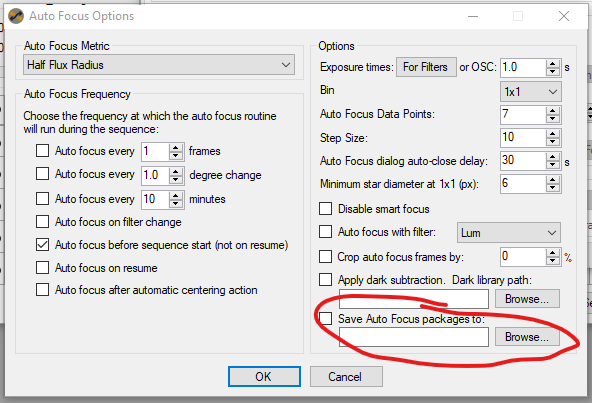Its the false readings especially when using a SCT scope. I have two piers in the observatory, the other with a TMB130 refractor, which I rarely if ever I have focus problems. I just want bulletproof focus, so I don’t have to actively monitor it. I know the SGpro can measure stars much larger than FWHM 9, it just gets confused when many of them have donuts…
For a large, long focal length scope, the SGP autofocus routine does not work well at all, for a variety of reasons. Thanks to some heroic improvement efforts a couple of years ago, the routine actually does a very good job of detecting donuts, as long as they are bright enough. The problem I regularly experience is that a star field always contains stars of varying brightness. SGP does a great job of calculating the size of the bright donuts, but for the dimmer ones, it frequently identifies only a small part of the donut as a star. That, of course, means that a much smaller HFR goes into the calculation and throws off the entire routine. Longer exposures don’t help much - it will produce more bright donuts, but dimmer stars that would not produce detectable donuts at all now get only part of the donut detected. Of course, then there are galactic nuclei and globs that get selected as stars, skewing the HFR calculation the other way. For my EdgeHD 14, autofocus is for all intents and purposes useless.
All of this could be avoided with a simple outlier rejection routine that tosses out stars that are much larger or smaller than the average at each point. Sadly, I was very disappointed to see Jared post in another thread that they haven’t even started working on improving autofocus yet. I have been hoping against hope that they were working on this behind the scenes, particularly since this is the one problems that people have been the most vocal about and that is driving so many people to use other software. Sadly, it looks like I may have be be one of them, at least for when I use the EdgeHD 14. SGP has several features that are awesome, that I don’t want to do without and are not offered by other software, but those features are meaningless if focus doesn’t work.
Tim
We’ll be starting on the auto focus enhancements soon. What would be helpful are auto focus packs especially where the data seems ok but SGP failed to find good focus.
Thanks,
Jared
I’ll try to get some more, but I provided focus packs (now deleted from DropBox) when you asked for them a year and a half ago here:
What are focus packs??
I also totally agree on rejecting outliers would be a great start. When in focus I have a HFR or 2.6. I want to reject anything below that.
When there is a very bright star in the FOV, it will often identify part of the star and not the whole star.
Star clusters are also problematic, three stars will be calculated as one when close together. I am not too worried about this one because the group should be proportional as you focus.
Just having algorithms that more carefully select stars I think would help. Maybe fewer stars.
I don’t have problems on my refractor, nice v curves.
In the auto focus settings you can save Auto Focus packs. These are all of the images that are taken in an auto focus run. We can use them to “play back” the actual focus run and analyze how focus was determined and adjust the algorithm.

Thanks,
Jared
Ok I will send you one… Bruce
Since you are now considering working on improving star detection, I will make an observation that I have noticed for a long time but have not mentioned.
The current star detection algorithm chooses different stars on different images. This adds an element of comparing apple to oranges. In other words, when there are different stars contributing to the average HFR for an image, the accuracy of the collection of images that make up one focus run is degraded. This shows up dramatically in the examples many people have given for long focal length scope with small FOV, such that only a few stars are in the image.
Compound that with including multiple stars as a single star, and it is no wonder focus does not work in these situations. Including multiple star images is comparable to including nebula, the sensitivity of the HFR value is degraded by a factor of about 10. When small stars will go from hfr of 2 to 6 over a run which is a 300% increase, the typical multi-star star has its hfr go from 10 to 13, a 30% increase.
Correct. For images where we have lots of samples this works fine but when there are few stars that can cause a large impact. If I recall we did go through some iterations where we would preserve the selected stars for each AF frame. But at the time we saw little difference with the gear we were testing with at the time and didn’t see any benefit. But it’s certainly worth revisiting this especially when we have a small amount of detected starts.
Jared